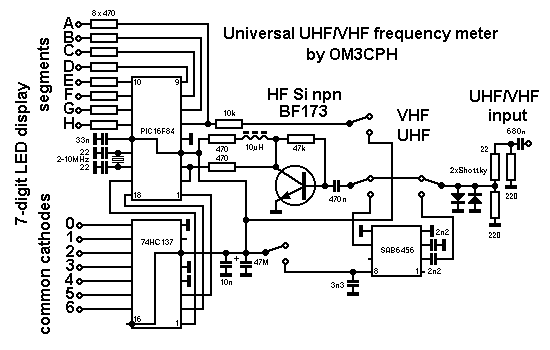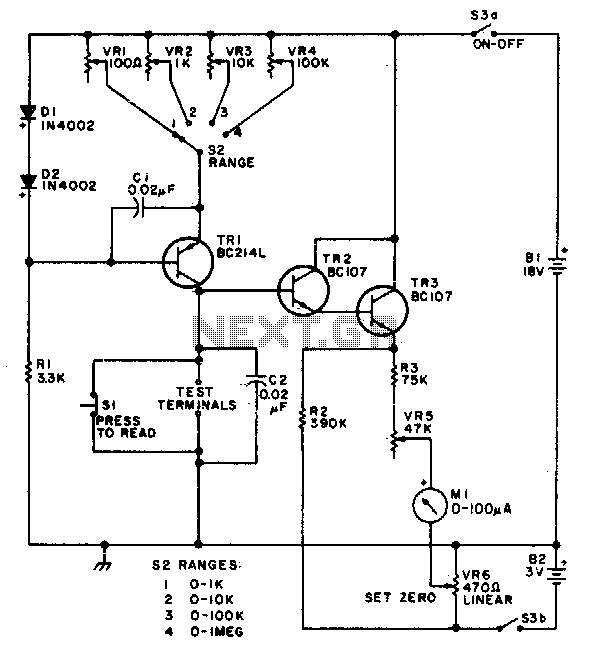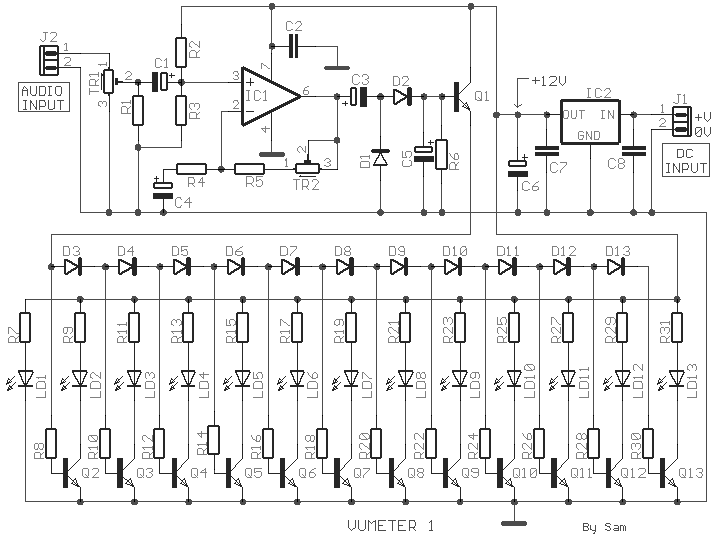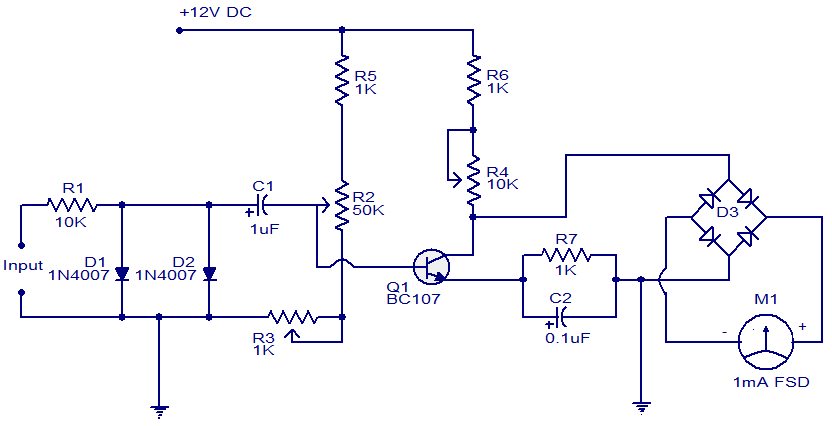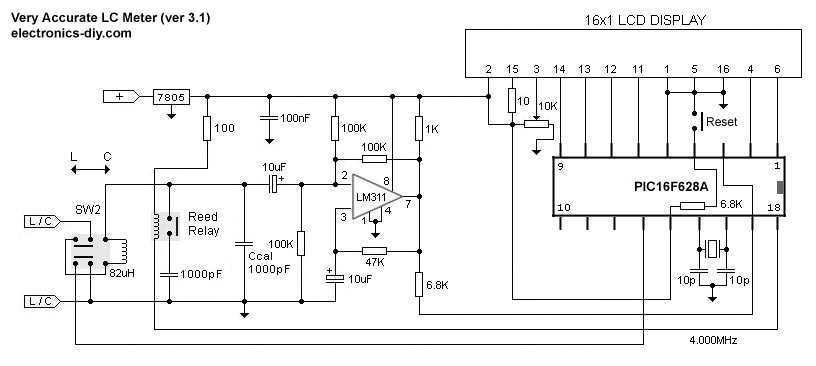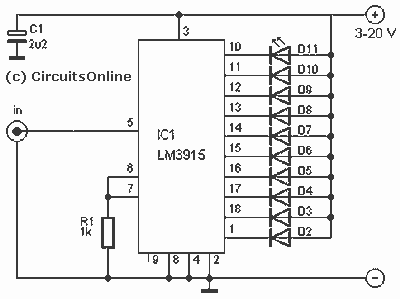
ESR Meter
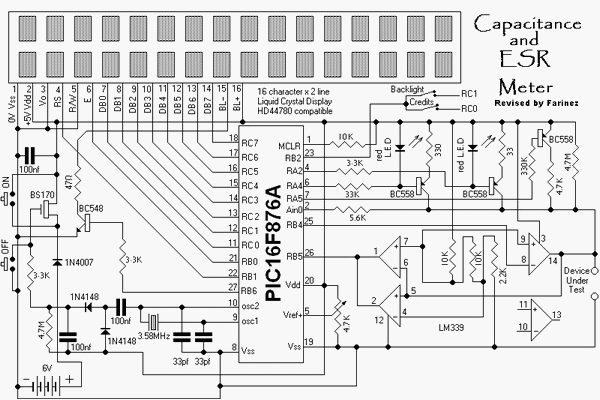
Use a capacitor with a value of approximately 100 to 1000 microfarads and connect a small resistor, either 5 or 10 ohms, in series with it. Attach this assembly to a meter and adjust the potentiometer until the meter displays the resistance of the resistor. This process should be repeated with different capacitors and resistors to verify calibration. Limitations: Capacitors smaller than about 10 microfarads cannot be accurately measured for Equivalent Series Resistance (ESR). Capacitance values down to 10 picofarads can be measured; however, devices with significant leakage cannot be accurately measured for capacitance.
In this circuit setup, the primary objective is to measure the Equivalent Series Resistance (ESR) of capacitors using a simple series configuration with a known resistor. The use of capacitors ranging from 100 to 1000 microfarads allows for a broad range of applications, as these components are commonly found in power supply circuits and signal filtering applications. The 5 or 10-ohm resistor serves as a reference resistance that can be accurately measured with a multimeter or dedicated ESR meter.
The connection process involves placing the capacitor in series with the resistor, ensuring that the polarity of the capacitor is observed if it is polarized. The meter is then connected across the resistor, allowing for the measurement of voltage drop across it. By adjusting the potentiometer in the circuit, the user can calibrate the meter to read the resistance value of the resistor directly. This calibration step is crucial for ensuring accurate readings during subsequent tests with various capacitors.
It is important to note the limitations of this measurement technique. Capacitors with values smaller than approximately 10 microfarads may not yield reliable ESR readings due to their inherent characteristics. Additionally, while capacitance can be measured down to 10 picofarads, components with significant leakage currents—such as electrolytic capacitors nearing the end of their lifespan—will not provide accurate capacitance measurements. This limitation must be considered when evaluating the reliability of the measurements obtained from this circuit configuration.
Overall, this simple yet effective setup allows for the practical assessment of capacitor health and performance, aiding in the maintenance and troubleshooting of electronic equipment. Proper calibration and understanding of the limitations will enhance the accuracy and reliability of the measurements taken.Take a good capacitor, around 100 or 1000 microfarads, and connect a small resistor, 10 or 5 ohms, in series with it. Connect to the meter and adjust that pot until the meter reads the resistance of that resistor. Repeat with other capacitors and resistors as a check on your calibration. Limitations:Capacitors smaller than about 10 mi crofarads cannot be measured with ESR. Capacitance down to 10 picofarads may be measured, however devices with appreciable leakage cannot be measured at all for capacitance. 🔗 External reference
In this circuit setup, the primary objective is to measure the Equivalent Series Resistance (ESR) of capacitors using a simple series configuration with a known resistor. The use of capacitors ranging from 100 to 1000 microfarads allows for a broad range of applications, as these components are commonly found in power supply circuits and signal filtering applications. The 5 or 10-ohm resistor serves as a reference resistance that can be accurately measured with a multimeter or dedicated ESR meter.
The connection process involves placing the capacitor in series with the resistor, ensuring that the polarity of the capacitor is observed if it is polarized. The meter is then connected across the resistor, allowing for the measurement of voltage drop across it. By adjusting the potentiometer in the circuit, the user can calibrate the meter to read the resistance value of the resistor directly. This calibration step is crucial for ensuring accurate readings during subsequent tests with various capacitors.
It is important to note the limitations of this measurement technique. Capacitors with values smaller than approximately 10 microfarads may not yield reliable ESR readings due to their inherent characteristics. Additionally, while capacitance can be measured down to 10 picofarads, components with significant leakage currents—such as electrolytic capacitors nearing the end of their lifespan—will not provide accurate capacitance measurements. This limitation must be considered when evaluating the reliability of the measurements obtained from this circuit configuration.
Overall, this simple yet effective setup allows for the practical assessment of capacitor health and performance, aiding in the maintenance and troubleshooting of electronic equipment. Proper calibration and understanding of the limitations will enhance the accuracy and reliability of the measurements taken.Take a good capacitor, around 100 or 1000 microfarads, and connect a small resistor, 10 or 5 ohms, in series with it. Connect to the meter and adjust that pot until the meter reads the resistance of that resistor. Repeat with other capacitors and resistors as a check on your calibration. Limitations:Capacitors smaller than about 10 mi crofarads cannot be measured with ESR. Capacitance down to 10 picofarads may be measured, however devices with appreciable leakage cannot be measured at all for capacitance. 🔗 External reference
